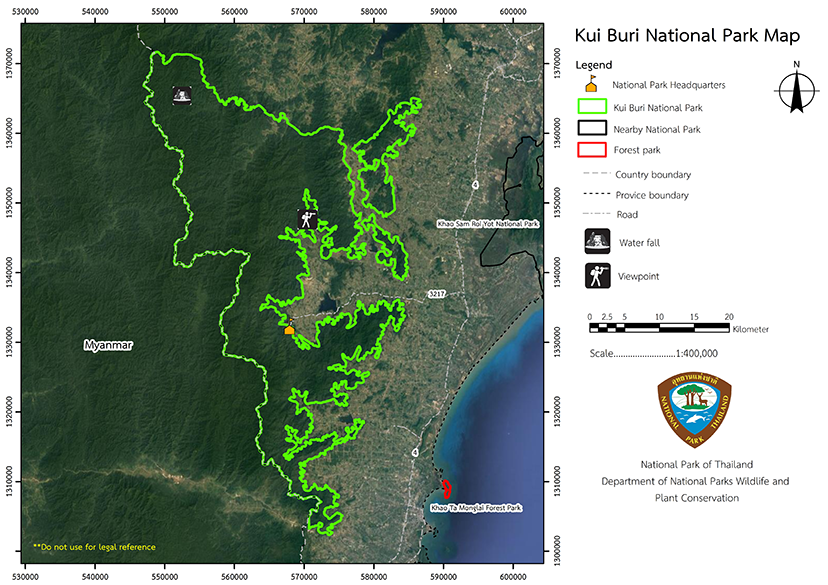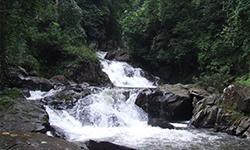Kui Buri National Park
Contact Location : Moo 9, Ban Yan Sue, Hat Kham Sub-district, Kui Buri District, Prachuap Khiri Khan Province or PO Box 10, Kui Buri Province Post Office, Kui Buri District, Prachuap Khiri Khan Province 77150
Telephone Number : (+66) 3 251 0453, (+66) 8 1776 2410
Email : kuiburi_np@hotmail.co.th, kuiburi_np@hotmail.com
Facebook : Kui Buri National Park
Information
Kui Buri National Park is an area covered by Pranburi, Sam Roi Yot, Kui Buri, and Mueang Prachuap Khiri Khan District in Prachuap Khiri Khan Province.
This park is a watershed forest that contains significant and valuable natural resources such as plants, wildlife, and scenic views. In order to protect them from being destroyed or altered for the purpose of education and recreation it was promoted to National Park status, and the area covered by the park ins 605,625 rai (969 square kilometers).
Background
Forests in Thailand are being destroyed at an alarming rate, and there is concern that there will be insufficient forest to maintain the natural balance in future years. As a result, the Royal Forest Department issued order No. 475/2532 on March 22, 1989, requesting Mr. Jumpon Charoensukpanich, Forestry Officer Level 4 at National Park Division, to conduct a preliminary survey of the forests in Pranburi Forest Park, adjacent to Khlong Kao - Khlong Khoi National Reserved Forest (Pa Khlong Kao - Khlong Khoi). Additionally, the Royal Forest Department issued an order No. 1627/2532 dated October 19, 1989 to Mr. Sanphet Rakha, Forestry Officer Level 5 at the National Park Division, authorizing him to conduct additional surveys in order to proceed with the establishment of Kui Buri National Reserved Forest as a national park pursuant to the National Park Act 1961 by acting as the superintendent of Kui Buri National Park. The survey's findings indicate that the area is predominantly folded complex mountain landscape, which has a large forest area in the west, adjacent to Myanmar border. It is part of Tanaosi Mountain range, and consists of tropical rain forests, dry evergreen forests, and mixed deciduous forests, all of which are densely forested. It is home to economically valuable woods and a diverse array of wildlife. However, as humans have encroached upon the area for cultivation it is not as diverse as it once was. According to the survey report No. Ko So 0713 (Ko Ro)/19 dated 29 January 1993, the majority of the encroachment has been pineapple farming and housing.
The National Parks Division of the Royal Forest Department proposed to the National Park Board to establish the park, and a resolution was passed at meeting No. 2/2537 on April 20th, 2537, to designate the Kuiburi Forest Area as a National Park. The Royal Forest Department was taking action to recover the Kuiburi Forest, and it was designated a National Park in the National Parks Act 1961. A Royal Decreewas issued, and a total area of 605,625 rai (969 aquare kilometers) was specified, including forest land in Kuiburi in the areas of Khao Chao, Silalai, Salalai, Rai Kao, Rai Mai, Hat Kham, Sam Krathai, Kui Buri, Bo Nok, Ao Noi, Ko Lak, Khlong Wan Sub-district in Pranburi, Sam Roi Yot and Kui Buri and Mueang Prachuap Khiri Khan District, all of which are in Prachuap Khiri Khan Province. It was announced in the Government Gazette, Volume 116, Section 20 Ko, dated March 25th, 1999, and became Thailand’s 90th National Park.
Note : After paying the entrance fee to the National Park, please carry the receipt for inspection.

605,625 rai (969 square kilometer)
|
|
|
|
Nature trails ⇔ Observe flowers/plants ⇔ Bird/Butterfly ⇔ Wildlife watching activities ⇔ Camping
Welfare shop : open daily from 8:00 to 4:30 hrs. and sells coffee, drinking water, and snacks.
Mobile phone signal :
- Visitor center area: AIS, DTAC, TRUE
- National Park Ranger Station Ko Ro No. 1 (Pa Yang): AIS, DTAC, TRUE
- National Park Ranger Station Ko Ro No. 2 (Samrong): AIS, DTAC, TRUE
- National Park Ranger Station Ko Ro No. 3 (Dan Singkhon): AIS, DTAC, TRUE
- National Park Ranger Station Ko Ro No. 5 (Huai Luek): AIS, DTAC, TRUE
|
|
The majority of the area resembles folded comples mountains with west-to-east facing slopes and a mountain range that runs north and south. It is part of Tanaosi Mountain range, the mountain range that separates Thailand and Myanmar. The area is classified into two categories: |
|
The climate of Kui Buri National Park is a Tropical Savannah Climate with relatively high temperatures throughout the year. There are apparent dry periods in the year which are based on the geographic classification system and a feature of semi-arid climates. There are longer days in summer and shorter days in winter. There is only short period of excessive water supply. There are 3 seasons: Rainy season: Winter season: Summer season: |
|
|
|
Forest Resources 1.2) Tropical Rain Forest 1.3) Semi-Evergreen Forest, the majority of this forest (22.12% of the total area) is located between 400 and 900 meters above sea level along the ridge line that separates Thailand and Myanmar. When approaching the area from the north and center it appear a larger forest in this type. The ecosystem can be classified into 3-4 levels. The canopy has a height of about 30-35 meters and includes trees such as Parkia leiophylla Kurz, Antidesma velutinosum Blume, Dipterocarpus costatus C.F. Gaertn, Dipterocarpus dyeri Pierre, Nitta tree, Strychnos nux-blanda A.W. Hill, and Livistona speciosa Kurz. The lower canopy involves Paramichelia baillonii (Pierre) Hu, Aphanamixis polystachya (Wall.) R.Parker, Java Plum, Knema angustifolia (Roxb.) Warb, Mangifera quadrifida, Thai Croton, Plum Mango, Korlan, Baccaurea parviflora, Nephelium maingayi, Stemonurus secundiflorus (Mast.) Sleumer, and Archidendron jiringa (Jack) I.C. Nielsen. The lower ground plants includes types of ferns that live on the soil and those that live on the boughs, and Rafflesia kerri. 1.4) Middle Dry Evergreen Forest extends from the east to the central region, almost to the Myanmar border, at an elevation of 350–650 meters above sea level (24.40 percent of the area). 1.5) Lower Dry Evergreen Forest This forest type occurs in the eastern part of the area between 100 and 400 meters above mean sea level (29.27 percent of the area). Only Prachuap Khiri Khan and Phetchaburi Provinces have this unique ecosystem. The Siamese rough bush, which grows to a diameter of more than 30 centimeters, is the top of Mansonia gagei, Cleistanthus sumatranus, Bungor, Staurochilus gibbosicalca, Renanthera isosepala are all additional species. 1.6) Dry Evergreen Forest mixed with deciduous forest 2. Deciduous Forest is found in only a few locations in the lower and upper areas, classified as a mixed deciduous forest. 2.1) Mixed Deciduous Forest 3. Other types of forests 3.1) Old Cleared Area 3.2) Bamboo Forest Wildlife Resources Preserved Wildlife found in Kui Buri National Park Asian Elephants in Kuiburi Guars Tiger |
How to get there by car :
From Bangkok, visitors can drive towards Prachuap Khiri Khan Province. From there, there is By carinto the forest area in Kui Buri District in Prachuap Khiri Khan Province. From the National Highway No. 4 (Phetkasem Road) about the milestone No. 295, turn right onto Provincial Highway No. 3217 (Kui Buri-Yang Chum) and travel towards Kui Buri District Office for about 3 kilometers. It approximately 18 kilometers from Ban Yang Chum through Yang Chum Dam, then turn left before reaching the Ban Yang Chum Reservoir Project. Visitors must observe an intersection, follow the route and go to Ban Yan Sue for about 10 kilometers. They must reach Ban Yan Sue and continue driving for another 2 kilometers until they reach Kui Buri National Park Headquarters. This is a paved road that leads to Kui Buri National Park Headquarters.
- National Park Ranger Station Ko Ro No. 1 (Pa Yang)
- National Park Ranger Station Ko Ro No. 2 (Samrong)
- National Park Ranger Station Ko Ro No. 3 (Dan Singkhon)
- National Park Ranger Station Ko Ro No. 4 (Hup Masang)
- National Park Ranger Station Ko Ro No. 5 (Huai Luek)
- National Park Ranger Station Ko Ro No. 6 (Phraek Talui)
- Accommodation - Campground
- Seminar Meeting Room - Visitor Center
- Restrooms - All-Gender Restroom
- Restrooms - All-Gender Restroom
- Roads/trails – Roads in Kui Buri National Park


